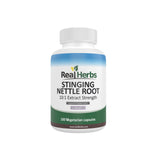Why Eat Stinging Nettles?
Introduction
When you think of nettles, the first thing that might come to mind is the unpleasant sensation of being stung by their fine, hair-like structures. However, these seemingly bothersome plants offer a hidden treasure trove of health benefits. In this article, we'll delve into the world of stinging nettles (scientifically known as Urtica dioica) to discover why you should consider incorporating them into your diet.
What Are Stinging Nettles?
Stinging nettles are perennial plants known for their distinctive serrated leaves and tiny, yet potent, stinging hairs. They are often found in temperate regions around the world and have a long history of use in various cultures.
Historical and Culinary Background
Throughout history, stinging nettles have been valued for both their culinary and medicinal properties. Ancient Romans, for example, cultivated nettles for their purported healing powers. In the culinary world, nettles are known for their versatility. They've been used in soups, teas, and even as a substitute for spinach in various dishes.
Nutritional Profile
The nutritional composition of stinging nettles is truly impressive. They are a rich source of vitamins, including vitamin A, C, and K, along with an array of essential minerals, such as iron, calcium, and magnesium. Additionally, stinging nettles contain compounds like flavonoids and antioxidants, making them a valuable addition to a balanced diet.
Health Benefits
-
Anti-inflammatory Properties: Stinging nettles have long been associated with reducing inflammation in the body, potentially helping those with conditions like arthritis or allergies.
-
Allergy Relief: Some individuals have found relief from seasonal allergies by consuming nettle-based remedies, which are believed to alleviate allergic reactions.
-
Nutrient Density: Nettles are incredibly nutrient-dense, offering a natural source of essential vitamins and minerals that can support overall health.
-
Joint and Bone Health: The calcium content in stinging nettles is good for bone health, and they may aid in reducing joint pain and inflammation.
-
Blood Sugar Control: Emerging research suggests that stinging nettles may help regulate blood sugar levels, which is beneficial for those with diabetes or prediabetes.
-
Digestive Health: Nettles have been traditionally used to support gastrointestinal health and soothe digestive discomfort.
How to Prepare and Eat Stinging Nettles
Before you incorporate stinging nettles into your diet, it's essential to know how to handle them safely. The stinging hairs contain chemicals that can irritate the skin, so proper preparation is key. Here's a simple way to prepare them for consumption:
-
Harvest: Wear gloves and carefully harvest young, tender nettle leaves in the spring or early summer.
-
Blanch: Submerge the leaves in boiling water for a few minutes to neutralize the stinging hairs.
-
Cook: Use blanched nettles in recipes like soups, pesto, or stir-fries.
Remember that only the young, fresh leaves are typically used for culinary purposes.
Possible Side Effects and Precautions
While stinging nettles offer numerous health benefits, it's important to be aware of potential side effects, such as skin irritation. Some individuals may also experience gastrointestinal discomfort. If you have allergies or are taking medications, consult with a healthcare professional before adding stinging nettles to your diet.
Where to Find Stinging Nettles
You can forage for stinging nettles in many regions, but exercise caution and follow proper guidelines for safe harvesting. Additionally, some stores and farmers' markets may carry fresh or dried nettles for purchase.
Conclusion
Stinging nettles may have a prickly reputation, but their potential health benefits make them worth considering as a dietary addition. With their anti-inflammatory properties, nutrient density, and culinary versatility, these plants have earned their place on the list of superfoods. Just remember to handle them with care, and consult your healthcare provider if you have any concerns. Why not give these remarkable plants a try and explore the world of stinging nettles for yourself?












